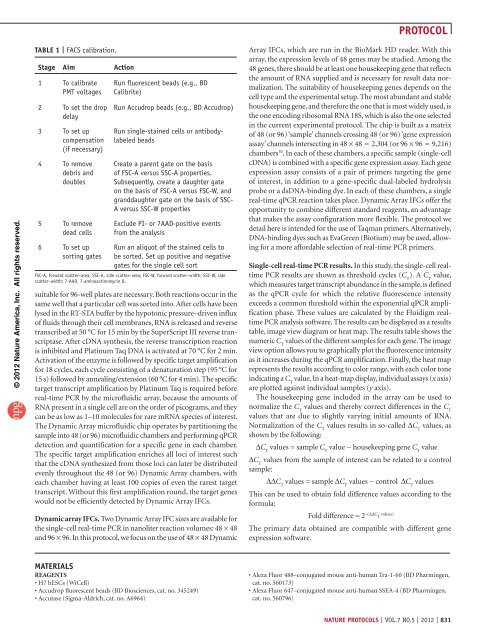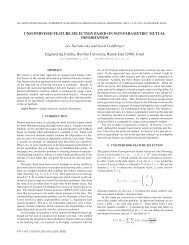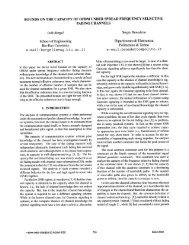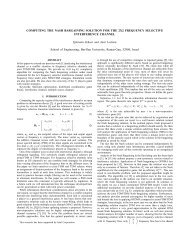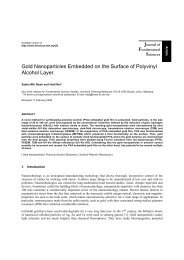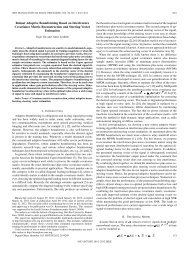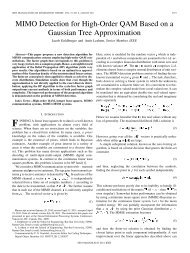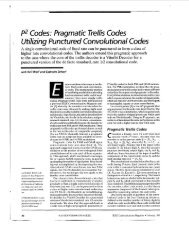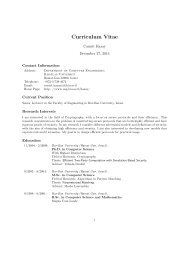Microfluidic single-cell real-time PCR for comparative analysis of ...
Microfluidic single-cell real-time PCR for comparative analysis of ...
Microfluidic single-cell real-time PCR for comparative analysis of ...
Create successful ePaper yourself
Turn your PDF publications into a flip-book with our unique Google optimized e-Paper software.
protocol© 2012 Nature America, Inc. All rights reserved.Table 1 | FACS calibration.Stage Aim Action1 To calibratePMT voltages2 To set the dropdelay3 To set upcompensation(if necessary)4 To removedebris anddoubles5 To removedead <strong>cell</strong>s6 To set upsorting gatesRun fluorescent beads (e.g., BDCalibrite)Run Accudrop beads (e.g., BD Accudrop)Run <strong>single</strong>-stained <strong>cell</strong>s or antibodylabeledbeadsCreate a parent gate on the basis<strong>of</strong> FSC-A versus SSC-A properties.Subsequently, create a daughter gateon the basis <strong>of</strong> FSC-A versus FSC-W, andgranddaughter gate on the basis <strong>of</strong> SSC-A versus SSC-W propertiesExclude PI- or 7AAD-positive eventsfrom the <strong>analysis</strong>Run an aliquot <strong>of</strong> the stained <strong>cell</strong>s tobe sorted. Set up positive and negativegates <strong>for</strong> the <strong>single</strong> <strong>cell</strong> sortFSC-A, <strong>for</strong>ward scatter–area; SSC-A, side scatter–area; FSC-W, <strong>for</strong>ward scatter–width; SSC-W, sidescatter–width; 7-AAD, 7-aminoactinomycin D.suitable <strong>for</strong> 96-well plates are necessary. Both reactions occur in thesame well that a particular <strong>cell</strong> was sorted into. After <strong>cell</strong>s have beenlysed in the RT-STA buffer by the hypotonic pressure–driven influx<strong>of</strong> fluids through their <strong>cell</strong> membranes, RNA is released and reversetranscribed at 50 °C <strong>for</strong> 15 min by the SuperScript III reverse transcriptase.After cDNA synthesis, the reverse transcription reactionis inhibited and Platinum Taq DNA is activated at 70 °C <strong>for</strong> 2 min.Activation <strong>of</strong> the enzyme is followed by specific target amplification<strong>for</strong> 18 cycles, each cycle consisting <strong>of</strong> a denaturation step (95 °C <strong>for</strong>15 s) followed by annealing/extension (60 °C <strong>for</strong> 4 min). The specifictarget transcript amplification by Platinum Taq is required be<strong>for</strong>e<strong>real</strong>-<strong>time</strong> <strong>PCR</strong> by the micr<strong>of</strong>luidic array, because the amounts <strong>of</strong>RNA present in a <strong>single</strong> <strong>cell</strong> are on the order <strong>of</strong> picograms, and theycan be as low as 1–10 molecules <strong>for</strong> rare mRNA species <strong>of</strong> interest.The Dynamic Array micr<strong>of</strong>luidic chip operates by partitioning thesample into 48 (or 96) micr<strong>of</strong>luidic chambers and per<strong>for</strong>ming q<strong>PCR</strong>detection and quantification <strong>for</strong> a specific gene in each chamber.The specific target amplification enriches all loci <strong>of</strong> interest suchthat the cDNA synthesized from those loci can later be distributedevenly throughout the 48 (or 96) Dynamic Array chambers, witheach chamber having at least 100 copies <strong>of</strong> even the rarest targettranscript. Without this first amplification round, the target geneswould not be efficiently detected by Dynamic Array IFCs.Dynamic array IFCs. Two Dynamic Array IFC sizes are available <strong>for</strong>the <strong>single</strong>-<strong>cell</strong> <strong>real</strong>-<strong>time</strong> <strong>PCR</strong> in nanoliter reaction volumes: 48 × 48and 96 × 96. In this protocol, we focus on the use <strong>of</strong> 48 × 48 DynamicArray IFCs, which are run in the BioMark HD reader. With thisarray, the expression levels <strong>of</strong> 48 genes may be studied. Among the48 genes, there should be at least one housekeeping gene that reflectsthe amount <strong>of</strong> RNA supplied and is necessary <strong>for</strong> result data normalization.The suitability <strong>of</strong> housekeeping genes depends on the<strong>cell</strong> type and the experimental setup. The most abundant and stablehousekeeping gene, and there<strong>for</strong>e the one that is most widely used, isthe one encoding ribosomal RNA 18S, which is also the one selectedin the current experimental protocol. The chip is built as a matrix<strong>of</strong> 48 (or 96) ‘sample’ channels crossing 48 (or 96) ‘gene expressionassay’ channels intersecting in 48 × 48 = 2,304 (or 96 × 96 = 9,216)chambers 30 . In each <strong>of</strong> these chambers, a specific sample (<strong>single</strong>-<strong>cell</strong>cDNA) is combined with a specific gene expression assay. Each geneexpression assay consists <strong>of</strong> a pair <strong>of</strong> primers targeting the gene<strong>of</strong> interest, in addition to a gene-specific dual-labeled hydrolysisprobe or a dsDNA-binding dye. In each <strong>of</strong> these chambers, a <strong>single</strong><strong>real</strong>-<strong>time</strong> q<strong>PCR</strong> reaction takes place. Dynamic Array IFCs <strong>of</strong>fer theopportunity to combine different standard reagents, an advantagethat makes the assay configuration more flexible. The protocol wedetail here is intended <strong>for</strong> the use <strong>of</strong> Taqman primers. Alternatively,DNA-binding dyes such as EvaGreen (Biotium) may be used, allowing<strong>for</strong> a more af<strong>for</strong>dable selection <strong>of</strong> <strong>real</strong>-<strong>time</strong> <strong>PCR</strong> primers.Single-<strong>cell</strong> <strong>real</strong>-<strong>time</strong> <strong>PCR</strong> results. In this study, the <strong>single</strong>-<strong>cell</strong> <strong>real</strong><strong>time</strong><strong>PCR</strong> results are shown as threshold cycles (C T). A C Tvalue,which measures target transcript abundance in the sample, is definedas the q<strong>PCR</strong> cycle <strong>for</strong> which the relative fluorescence intensityexceeds a common threshold within the exponential q<strong>PCR</strong> amplificationphase. These values are calculated by the Fluidigm <strong>real</strong><strong>time</strong><strong>PCR</strong> <strong>analysis</strong> s<strong>of</strong>tware. The results can be displayed as a resultstable, image view diagram or heat map. The results table shows thenumeric C Tvalues <strong>of</strong> the different samples <strong>for</strong> each gene. The imageview option allows you to graphically plot the fluorescence intensityas it increases during the q<strong>PCR</strong> amplification. Finally, the heat maprepresents the results according to color range, with each color toneindicating a C Tvalue. In a heat-map display, individual assays (x axis)are plotted against individual samples (y axis).The housekeeping gene included in the array can be used tonormalize the C Tvalues and thereby correct differences in the C Tvalues that are due to slightly varying initial amounts <strong>of</strong> RNA.Normalization <strong>of</strong> the C Tvalues results in so-called ∆C Tvalues, asshown by the following:∆C Tvalues = sample C Tvalue − housekeeping gene C Tvalue∆C Tvalues from the sample <strong>of</strong> interest can be related to a controlsample:∆∆C Tvalues = sample ∆C Tvalues − control ∆C TvaluesThis can be used to obtain fold difference values according to the<strong>for</strong>mula:Fold difference = 2 –(∆∆C T values)The primary data obtained are compatible with different geneexpression s<strong>of</strong>tware.MATERIALSREAGENTS• H7 hESCs (WiCell)• Accudrop fluorescent beads (BD Biosciences, cat. no. 345249)• Accutase (Sigma-Aldrich, cat. no. A6964)• Alexa Fluor 488–conjugated mouse anti-human Tra-1-60 (BD Pharmingen,cat. no. 560173)• Alexa Fluor 647–conjugated mouse anti-human SSEA-4 (BD Pharmingen,cat. no. 560796)nature protocols | VOL.7 NO.5 | 2012 | 831


